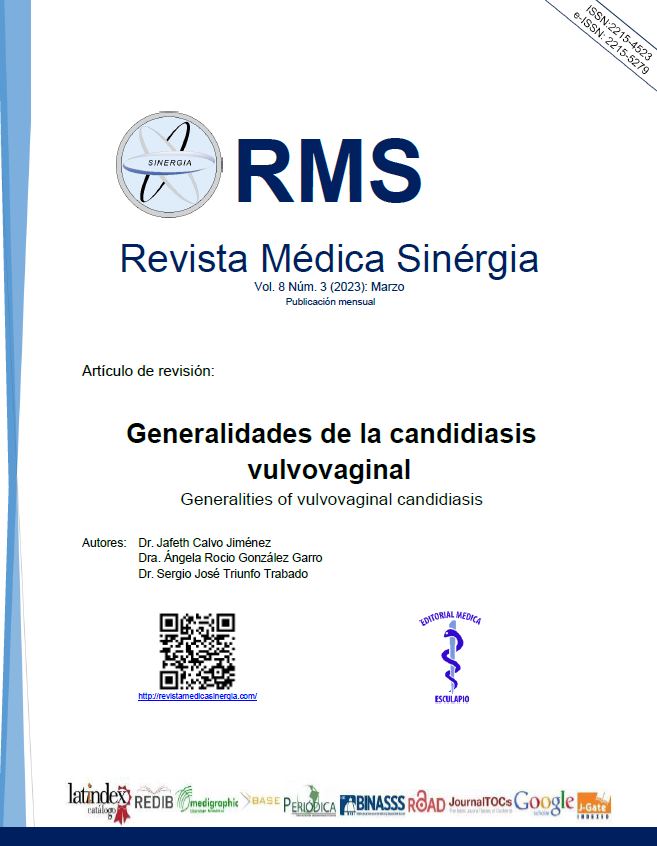Abstract
Vulvovaginal Candidiasis is a disease caused by Candida species, mainly Candida albicans, which can colonize the vaginal mycoflora of healthy women, without causing disease. It is the second most common cause of vaginitis, only surpassed by bacterial vaginosis. Due to its high prevalence, it is one of the most frequent reasons for gynecological consultation, it mainly affects women of reproductive age, and up to 75% of women will present an episode in their life. It is clinically characterized by itching, vaginal inflammation and whitish discharge. The diagnosis is made specifically by laboratory techniques such as direct microscopy or, failing that, culture. The pathogenesis is multifactorial and involves an unbalanced microbiota, host predisposing factors, the virulence of candida strains, and genetic polymorphisms of both host and host. Women with a higher risk of presenting vulvovaginal candidiasis are those with a high estrogen load or with some degree of immunocompromise. The treatment consists of azole antifungals, particularly fluconazole. However, the acquired and intrinsic resistance of non-albicans species is of concern, forcing the use of other strategies. This article consists of a bibliographical review, on the generalities of vulvovaginal Candidiasis, focusing on its epidemiology, pathogeny, correct diagnosis and treatment.
Keywords
References
Balakrishnan S, Yamang H, Lorenz M, Chew S, Lung L. Role of vaginal mucosa, host immunity and Microbiota in Vulvovaginal candidiasis. Pathogens. 2022; 11(618): 1- 15.
Rodríguez C, Carnero M, Molares A, López A, Fabbrocini G, Bardhi B, et al. Biofilms and Vulvovaginal candidiasis. Elsevier Colloids and Surfaces B: Biointerfaces. 2018; 174: 110- 125.
Sobel J, Mitchell C. Candida vulvovaginitis: clinical manifestations and diagnosis. Up to date. 2022; 1- 22.
Paladin H, Desai U. Vaginitis: Diagnosis and Treatment. American Family Physician. 2018; 97(5): 321- 319.
Blostein F, Sparenberg E, Wagner J, Forman B. Recurrent Vulvovaginal candidiasis. Elsevier Annals of Epidemiology. 2017; 27: 575- 582.
Sobel J, Sobel R. Current treatment options for Vulvovaginal candidiasis caused by azole-resistant candida species. Expert Opinion on Pharmacotherapy. 2018; 19(9): 971- 977.
Lírio J, Giraldo P, Luce R, Alves A, Ferreira A, Gonçalves A. Antifungal (oral and vaginal) therapy for recurrent vulvovaginal candidiasis: a systematic review protocol. BMJ Journals. 2019; 9: 1-6.
Denning D, Kneale M, Sobel J, Richardson R. Global burden of recurrent Vulvovaginal candidiasis: a systematic review. The Lancet. 2018; 1- 9.
Farr A, Effendy I, Frey B, Hof H, Mayser P, Petricevic L, et al. Guideline: Vulvovaginal candidosis (AWMF 015/072, level S2k). Wiley. 2021; 64: 583- 602.
Rósate D, Bruno M, Jaeger M, ten Oever J, Nerea M. Recurrent Vulvovaginal candidiasis: an immunological perspective. Microorganism. 2020; 8(144): 1- 14.
Katia N, Singh J, Kaur M. Microbiota in vaginal health and pathogenesis of recurrent Vulvovaginal infections: a critical review. Annals of Clinical Microbiology and Antimicrobials. 2020; 19(5): 1- 19.
Lines A, Flynn I, Searle C. Recurrent Vulvovaginal candidiasis. BMJ Journals. 2020; 369: 1- 4.
Sobel J. Candida vulvovaginitis: treatment. Up to date. 2022. 1- 24.
Sobel J, Mitchell C. Bacterial Vaginosis: Clinical manifestations and diagnosis. Up to date. 2022. 1- 34.
Sobel J, Mitchell C. Thichomoniasis: Clinical manifestations and diagnosis. Up to date. 2022. 1- 27.
Han Y, Ren Q. Does probiotics work for bacterial vaginosis and vulvovaginal candidiasis. Current Opinion in Pharmacology. 2021; 61: 83- 90.
Buggio, Somigliana E, Borgnine A, Vercellini P. Probiotics and vaginal microecology: fact or fancy?. BMC Women’s Health. 2019; 19(25): 1- 6.
Shenoy A, Gottlieb A. Probiotics for oral and vulvovaginal candidiasis: A review. Dermathologic Therapy. 2019; 1- 13.

This work is licensed under a Creative Commons Attribution-NonCommercial 4.0 International License.
Copyright (c) 2023 Array


